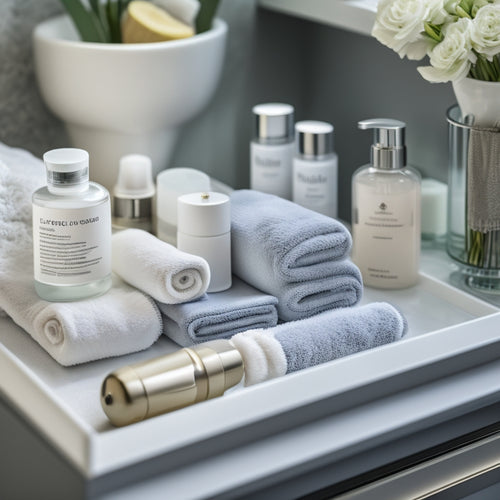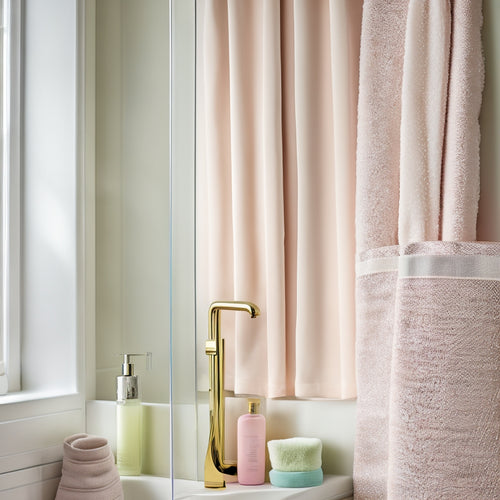
Revamp Organization: DIY Vinyl Labels Made Simple
Share
I'm done with cluttered labels and messy storage bins! To revamp my organization, I'm taking matters into my own hands with DIY vinyl labels. With a few essential materials like adhesive-backed vinyl and a Cricut cutting machine, I can create custom labels that fit my style. I design and cut my vinyl with ease, then apply them smoothly with transfer tape and a burnishing tool. For a more personal touch, I can even try handmade label alternatives like handwriting or decal designs. Now that I've got the basics down, I'm excited to explore more creative ways to organize my space and make it shine.
Key Takeaways
• Use adhesive-backed vinyl and a Cricut cutting machine to create custom labels for storage bins and containers.
• Design labels with a font and arrangement that fits the bin, and cut out excess vinyl after cutting.
• Apply vinyl labels smoothly by using transfer tape, pressing letters onto it, and smoothing out bubbles with a credit card.
• Explore handmade label alternatives, such as handwritten labels or drawing on adhesive-backed vinyl, for small, one-off labels.
• Revamp organization by repurposing old containers, such as turning mason jars into desk organizers or transforming old crates into shelves.
Essential Materials and Tools
I head to my local craft store or browse online to gather the essential materials and tools needed to create my DIY vinyl labels. This includes adhesive-backed vinyl, a Cricut cutting machine or similar tool, vinyl transfer tape, a burnishing tool, and 505 Temporary Adhesive Spray. With these basics, I can bring my vinyl design to life.
I'm excited to experiment with different cutting techniques to achieve the perfect shape and size for my labels. The Cricut cutting machine will make it easy to precision-cut my design, while the vinyl transfer tape will help me apply the labels smoothly. The burnishing tool will secure a strong bond between the vinyl and the surface.
With these tools, I'm ready to create custom labels that will elevate my organization game.
Designing and Cutting Vinyl
Selecting the perfect font and typing out the desired words into a design tool is the first step in bringing my vinyl label vision to life. I arrange and position the words to fit the limited space on my storage bins.
Next, I cut a vinyl strip and place it on the cutting mat. I connect my design tool to my Cricut cutting machine and push the cut button. The machine precisely cuts out the letters, and I peel off the excess vinyl, leaving only the letters stuck to the adhesive backing.
With my vinyl design ready, I'm now ready to move on to the next step. I'll use cutting techniques like weeding out excess vinyl to ensure a clean and precise label.
Applying Vinyl Labels Smoothly
With my vinyl design ready, I'm prepared to transfer the labels to my storage bins, guaranteeing a smooth application by cutting transfer tape to size and placing the sticky side on the vinyl words.
To make sure a bubble-free application, I gently press the letters onto the tape, ensuring they're centered and even. Then, I peel up the transfer tape and apply the labels to my storage bins.
Here's a quick rundown of my application process:
- Carefully position the label on the bin, smoothing out any air bubbles as I go
- Use a credit card or similar tool to smooth out any remaining bubbles
- Apply gentle pressure to guarantee the label adheres smoothly
- Peel off the transfer tape slowly and carefully to reveal the finished label
Handmade Label Alternatives
When precision cutting isn't necessary, handmade label alternatives offer a more tactile approach to labeling storage bins. I love exploring creative options like handwritten labels, which add a personal touch to my organization system.
For a unique look, I opt for decal design, which allows me to customize my labels with colorful patterns and shapes. To create these labels, I simply write or draw on adhesive-backed vinyl with a fine-tip marker or pen. Then, I cut out the label and apply it to my storage bin.
This method is perfect for small, one-off labels or when I want to add a dash of personality to my storage system. Plus, it's a great way to get creative and have fun with organization!
Beyond Label Making
I take my organization system to the next level by repurposing old containers and turning them into functional storage bins. This not only reduces waste but also adds a personal touch to my space.
I use my DIY vinyl labels to give these bins a cohesive look and make them easy to identify.
- Mason jars turned into desk organizers for pens and pencils
- Old crates transformed into shelves for books and decorative items
- Plastic containers repurposed as storage for crafting supplies
- Glass containers turned into unique vases for fresh flowers
Frequently Asked Questions
How Long Do Adhesive-Backed Vinyl Labels Typically Last?
"I've found that adhesive-backed vinyl labels can last anywhere from six months to several years, depending on environmental factors like exposure to sunlight, moisture, and wear-and-tear, which affect their durability and overall lifespan."
Can I Remove Vinyl Labels Without Damaging the Surface?
"I've tried to remove vinyl labels a million times, but it's a delicate dance! To avoid damaging the surface, I use Label Removers or Surface Protectors to gently lift the label, taking my time to avoid scratches or residue."
Are Vinyl Labels Suitable for Outdoor or Weathered Surfaces?
When using vinyl labels outdoors, I make sure material selection is durable and waterproof, and surface preparation is key - cleaning and drying the area thoroughly before applying the label for a strong, long-lasting bond.
Can I Use a Different Type of Adhesive for Specific Surfaces?
When working with specific surfaces, I test adhesives to guarantee a strong bond; I explore adhesive options, considering factors like surface type, weather resistance, and durability to find the perfect match for my project's needs.
Are There Any Specific Vinyl Label Maintenance or Cleaning Tips?
"I'm relieved to swap dusty shelves for sleek labels, but then reality hits: how do I keep them looking fresh? I use label protection methods like laminate or clear acrylic spray and clever storage techniques like stacking bins to prevent scratches and fading."
Related Posts
-

Stylish Glass Door Storage Solutions
Stylish glass door storage solutions transform your spaces into stunning showcases. These sleek designs maximize spac...
-

Revamp Your Bathroom Drawers With Custom Organizer
I'm revamping my cluttered bathroom drawers with a custom organizer that's both functional and visually appealing. I ...
-

Craft Your Own Multi-Pocket Bath Caddy
We're about to craft a multi-pocket bath caddy that's both functional and stylish! To get started, we'll prepare our ...


